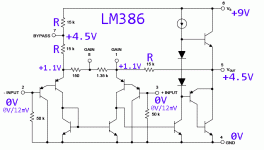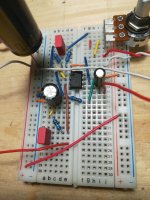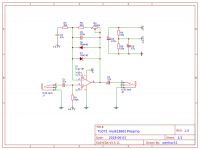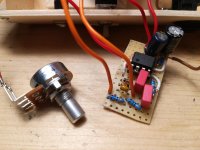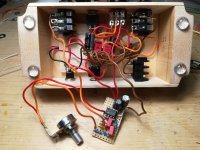I have told time and time again, it is NOT the headphones. They are not crappy and they are not defective. I'm using different sets of low impedance studio headphones that are proven to work as expected.
As far as I have learnt from the last couple of days (and I am very thankfull for all you guys explaining that to me and offering advice) it is indeed a power issue. So far the only thing that reduced the crackles was upping the voltage to 12V. IMHO I have to either accept that or get higher supply voltage. I could do that with a power pump like the 7660 and up the voltage this way to 12V - 15V. But I'm not sure if that is not overkill.
As far as I have learnt from the last couple of days (and I am very thankfull for all you guys explaining that to me and offering advice) it is indeed a power issue. So far the only thing that reduced the crackles was upping the voltage to 12V. IMHO I have to either accept that or get higher supply voltage. I could do that with a power pump like the 7660 and up the voltage this way to 12V - 15V. But I'm not sure if that is not overkill.
The chip is designed to run off 9 volts minimum. Your battery is sagging too much.
If it must be portable, then maybe you can run it off 6-AAA batteries in series. That will give you more oomph. Or maybe 2-9V "transistor" batteries in series would work - but make sure your chip is rated for 18 volts first.
If it must be portable, then maybe you can run it off 6-AAA batteries in series. That will give you more oomph. Or maybe 2-9V "transistor" batteries in series would work - but make sure your chip is rated for 18 volts first.
I will exchange the battery for 6 AA NiMH with 2000mAh. I just have to find the place for it. 
Yep, I thought there must be a drawback. There are other voltage doublers, but 18V is too much for a LM386N-3 (op. 4V-12V, max. 15V). Would have to go for a LM386-N4 to accept that voltage (op. 5V-18V, max. 22V).
Yep, I thought there must be a drawback. There are other voltage doublers, but 18V is too much for a LM386N-3 (op. 4V-12V, max. 15V). Would have to go for a LM386-N4 to accept that voltage (op. 5V-18V, max. 22V).
...never actually used the LM386...
I'm more a LM380 man. But they share an interesting topology, worth knowing if you hang in this section. Been around since 1983 and has been a benchmark of low-cost audio for over three decades.
The inputs are PNP Darlingtons, which leaves headroom (boot room?) even with the inputs at Zero. An internal resistor zero-references the inputs if you do nothing else (or cap-couple). In this mode the bases actually float-up to 12.5mV, which works just the same.
The output is set to half-supply by the 2R-R network. There does seem to be a part-Volt error here. There's also part-Volt asymmetry in the output stage and these may complement each other; or the "15K" may be trimmed, or they maybe don't care (it is a pocket radio amp, not a precision lab/saloon amp).
The several "grades" of '386 are new since 1983, and are just voltage ratings. Being a VERY low-cost part, it was specced for the lowest voltage commonly fabbed (then). With the growth of fabbing, there is sometimes spare space in a higher-voltage process, and those are sold as "18V". However the device area, and dissipation ability, are the same for all the DIP parts: a half-Amp is all you get. This makes it pointless to go much over 9V for 8 Ohms loads (0.5A*8r= 4V peak, 8V peak-peak). FWIW, the original intent was 16r load on 9V battery, for good battery life with an economical voice-coil.
The app-notes always wanted a supply bypass cap "close" to the '386. Recently I am seeing reports of builds that work fine with older '386 but not with this-year's production, until an at-chip bypass cap was added (in addition to the explicit "bypass" at pin 7 to set gain correctly and reject supply crap). They maybe can't get the old/slow process any more, and new batches are too fast to be stable with old bypass habits.
Attachments
Last edited:
The chip is designed to run off 9 volts minimum.....
No, 4 volts. Marginally on a 3-AA cell pack for some hours, or a 4-AA pack for many hours.
The desired distortion happens at maximum output, about 3 Volts (on 9V supply). This is FAR too much to put into headphones! If you want to distort, without ear-bleed, you need to waste-off signal between LM386 and headphones. Put 330 Ohms to 100 Ohms between '386 and each headphone. (This will also reduce power drain, IF you really have supply-sag.)
last night i had a quick view with the oscope on my lm386-n1.
load was a sony headphone (~30 ohm), input sinus 1kHz.........
one hp speaker at the output: with 9v (regulated) psu the chipamp
begins to distort above around 6Vpp
and with 7,6V psu above 4Vpp.
with the two hp speakers paralelled (~ 15 ohm) at output
distortions begun at only 0,4Vpp (9V or 7,6V psu did not change a lot)........
strange.
perhaps you try out to test your lm386 with only one hp speaker?
load was a sony headphone (~30 ohm), input sinus 1kHz.........
one hp speaker at the output: with 9v (regulated) psu the chipamp
begins to distort above around 6Vpp
and with 7,6V psu above 4Vpp.
with the two hp speakers paralelled (~ 15 ohm) at output
distortions begun at only 0,4Vpp (9V or 7,6V psu did not change a lot)........
strange.
perhaps you try out to test your lm386 with only one hp speaker?
I'm more a LM380 man. But they share an interesting topology, worth knowing if you hang in this section. Been around since 1983 and has been a benchmark of low-cost audio for over three decades....
I remember that one, but again never used it myself for anything diy.
Interesting theory on the old vs new production, which makes a lot of sense actually as the old fabrication processes fall by the wayside.
with the two hp speakers paralelled (~ 15 ohm) at output
distortions begun at only 0,4Vpp (9V or 7,6V psu did not change a lot)........
strange.
.......there was a mistake in the headphone connector.
so with the hp speakers paralell and 9V psu i got ~6Vpp output
and around 4Vpp with 7,4V.
with a 9V / 160mAh accu battery and paralelled hp i saw only 3Vpp out and
the accu went down to 6,4V (at beginning distortion the signal jumped
around ,like a latch up effekt or sowhat).
I did the preamp yesterday. It is a TL071 with Diode Distortion. I hooked it up with its own power supply at first, but will integrate it fully later.
I had troubles with some loose contacts and a faulty pot, but apart from that it sounds great.
And the crackles are gone. HOORAY! Simple reason being that the preamp now does the Distortion and I don't have to drive the Poweramp as hard.
I'll post a schematic later on, but it is de facto the preamp from the mylk386 amp. I just changed the cap on the OUT for a 10uF which sounded better to me.
I had troubles with some loose contacts and a faulty pot, but apart from that it sounds great.
And the crackles are gone. HOORAY! Simple reason being that the preamp now does the Distortion and I don't have to drive the Poweramp as hard.
I'll post a schematic later on, but it is de facto the preamp from the mylk386 amp. I just changed the cap on the OUT for a 10uF which sounded better to me.
Attachments
Last edited:
No, 4 volts. Marginally on a 3-AA cell pack for some hours, or a 4-AA pack for many hours.
The desired distortion happens at maximum output, about 3 Volts (on 9V supply). This is FAR too much to put into headphones! If you want to distort, without ear-bleed, you need to waste-off signal between LM386 and headphones. Put 330 Ohms to 100 Ohms between '386 and each headphone. (This will also reduce power drain, IF you really have supply-sag.)
I agree with you about the gain structure. I didn't look at the datasheet for minimum voltage but are they all the same?
The 386 is the classic 9 volt battery powered amplifier chip. I haven't messed with them in decades but I always powered them with a 9 volt "transistor" battery. What went wrong with OP's circuit? Why did his problem go away when he raised the voltage? The circuit only needed to deliver a few tens of millivolts to work.
you really are after adding distortion to the mix and that's a classic type of circuit to do that.
Nice classic distortion circuit.
Small resistors in series with the diodes will "soften" the distortion. You can only try.
To the OP Pontiac - have you considered classic tube overdrives? There are small tubes that run off fairly low voltages (as low as 30 volts
@Fast Eddie: I sense your plan, but I have only just started building such things. I have changed a few parts in a tube amp, but I am not there yet to build something like that on my own. But I want to do that sometime. 
@ALL and especially Mooly: Thx for helping me out on this, I nearly gave up on this. But you solved it quickly for me. I have learned so much thanks to you.
Tomorrow I'll try to get me a nice box for this plus some proper batteries.
@ALL and especially Mooly: Thx for helping me out on this, I nearly gave up on this. But you solved it quickly for me. I have learned so much thanks to you.
Tomorrow I'll try to get me a nice box for this plus some proper batteries.
Attachments
- Status
- This old topic is closed. If you want to reopen this topic, contact a moderator using the "Report Post" button.
- Home
- Amplifiers
- Chip Amps
- Lost on LM386
